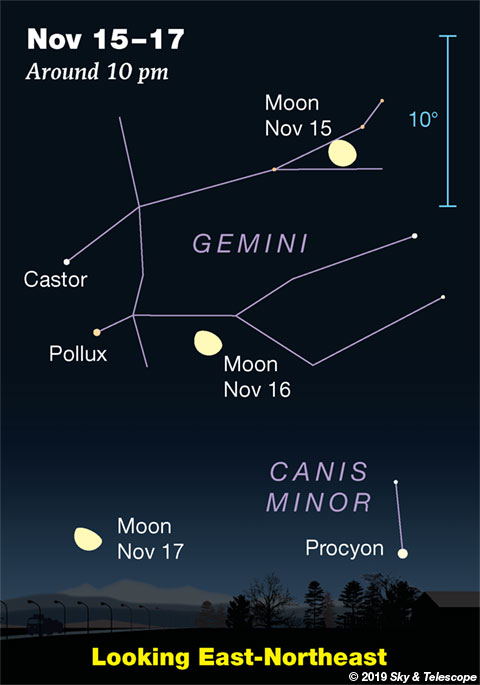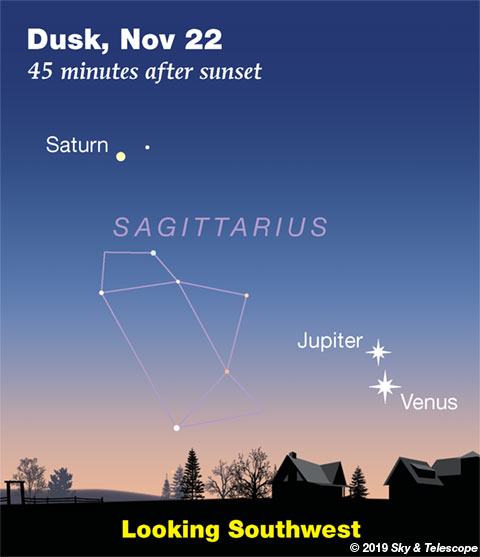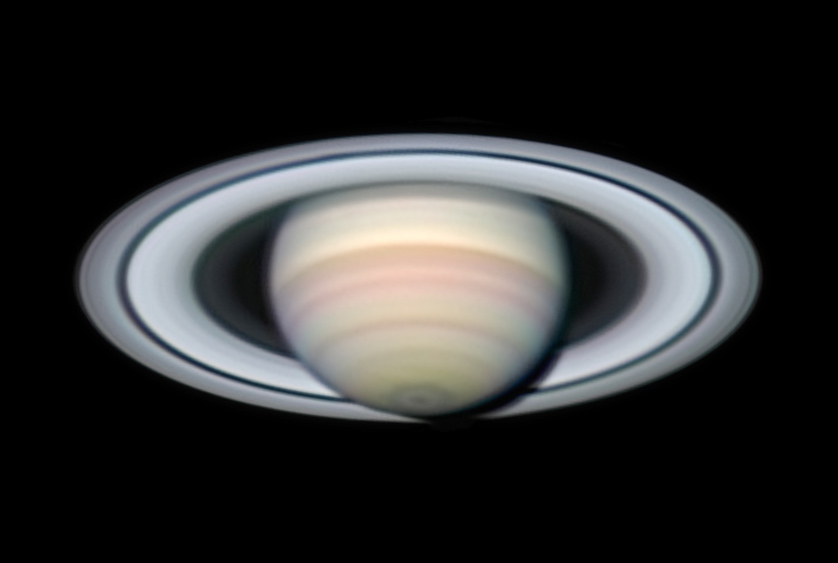
Friday, Nov. 15
• The waning gibbous Moon shines high by late evening. It's in Gemini, in the dim feet of the Castor stick-figure as shown here. Much easier to spot are Castor itself and Pollux, far to the Moon's lower left, as shown here.
Saturday, Nov. 16
• The waning gibbous Moon rises by 8 or 9 p.m. Once it's well up you'll see that it's still in Gemini, with Pollux now to its left and Castor above Pollux.
• The Leonid meteor shower should peak late tonight, but it's weak to begin with and the moonlight will interfere to boot. (However, see Thursday below!)
Sunday, Nov. 17
• Sometime around 8 p.m., depending on where you live, zero-magnitude Capella will have risen exactly as high in the northeast as zero-magnitude Vega has sunk in the west-northwest.
Monday, Nov. 18
• Vega is the brightest star in the west right after dark in November. Its little constellation Lyra extends to its left, pointing in the direction of Altair, the brightest star in the southwest.
Three of Lyra's leading stars, after Vega, are interesting doubles. Barely above Vega is 4th-magnitude Epsilon Lyrae, the famous Double-Double. Epsilon forms one corner of a roughly equilateral triangle with Vega and Zeta Lyrae. The triangle is less than 2° on a side, hardly the width of your thumb at arm's length.
Binoculars easily resolve Epsilon. And a 4-inch telescope at 100× or more should resolve each of Epsilon's wide components into a tight pair.
Zeta Lyrae is also a double star for binoculars; much tougher, but plainly resolved in any telescope.
Delta Lyrae, upper left of Zeta, is a much wider and easier pair.
Tuesday, Nov. 19
• Last-quarter Moon (exact at 5:11 p.m. EST). The Moon, in Leo, rises around midnight or 1 a.m. tonight with Regulus accompanying it a few degrees to its upper right. By early dawn Wednesday they're high in the south, with Regulus now directly to the Moon's right (by about 7° for North America).
Wednesday, Nov. 20
• Orion clears the eastern horizon by about 8 p.m. now, depending on how far east or west you live in your time zone. High above Orion shines orange Aldebaran. Above Aldebaran is the little Pleiades cluster, the size of your fingertip at arm's length.
Far left of Aldebaran and the Pleiades shines bright Capella.
Thursday, Nov. 21
• Meteor outburst tonight? Veteran meteor-stream analysts Peter Jenniskens and Esko Lyytinen are predicting that the Alpha Monocerotid meteor shower, usually very minor, may briefly erupt tonight to a rate of 100 to 400 meteors visible per hour as seen under ideal conditions. Their model predicts that Earth will pass through a very rich slice of the meteoroid stream for a mere 15 to 40 minutes centered on 4:50 November 22nd UT, which is 11:50 p.m. November 21st EST.
The shower's radiant, in Monoceros near Procyon, rises around 9 or 10 p.m. local time. When the radiant is low the meteors (all over the sky) will be much fewer than they would be under ideal conditions, but these few will be long, dramatic "Earth grazers" sailing far across the sky.
For westernmost Europe, the supposed eruption will happen with the radiant high shortly before dawn.
Of course, nothing might happen at all. Meteor forecasting is tricky. See Bob King's Intense Meteor Outburst Expected from the Alpha Monocerotids.
Update: Livestream video coverage of the possible shower, from Gianluca Masi and the Virtual Telescope Project.

Friday, Nov. 22
• Venus and Jupiter have closed to just 2° apart low in the southwest in twilight, as shown here. On Saturday and Sunday evenings they'll be even closer.
• Right after full darkness, Vega is the brightest star in the west. Its little constellation Lyra extends to its left. Somewhat farther left, about a fist and a half at arm's length from Vega, is 3rd-magnitude Albireo, the beak of Cygnus. This is one of the finest and most colorful double stars for small telescopes.
Saturday, Nov. 23
• In twilight this evening and tomorrow evening, Venus and Jupiter are just 1½° apart low in the southwest. Think photo opportunity.
• Around 7 or 8 p.m. now, the Great Square of Pegasus stands in its level position very high toward the south. (It's straight overhead if you're as far south as Miami.) Its right (western) side points very far down toward Fomalhaut. Its eastern side points less directly toward Beta Ceti (also known as Deneb Kaitos or Diphda), less far down.
What lurks below them? If you have a very good view down to a dark south horizon — and if you're not much farther north than roughly New York, Denver, or Madrid — picture an equilateral triangle with Fomalhaut and Beta Ceti as its top two corners. Near where the third corner would be is Alpha Phoenicis, or Ankaa, in the constellation Phoenix. It's magnitude 2.4, not very bright but the brightest thing in its area. It has a yellow-orange tint (binoculars help check). Have you ever seen anything of the constellation Phoenix before?
________________________
Want to become a better astronomer? Learn your way around the constellations. They're the key to locating everything fainter and deeper to hunt with binoculars or a telescope.
This is an outdoor nature hobby. For an easy-to-use constellation guide covering the whole evening sky, use the big monthly map in the center of each issue of Sky & Telescope, the essential guide to astronomy.

Once you get a telescope, to put it to good use you'll need a detailed, large-scale sky atlas (set of charts). The basic standard is the Pocket Sky Atlas (in either the original or Jumbo Edition), which shows stars to magnitude 7.6.
Next up is the larger and deeper Sky Atlas 2000.0, plotting stars to magnitude 8.5; nearly three times as many. The next up, once you know your way around, are the even larger Interstellarum atlas (stars to magnitude 9.5) and Uranometria 2000.0 (stars to magnitude 9.75). And read how to use sky charts with a telescope.
You'll also want a good deep-sky guidebook, such as Sue French's Deep-Sky Wonders collection (which includes its own charts), Sky Atlas 2000.0 Companion by Strong and Sinnott, or the bigger Night Sky Observer's Guide by Kepple and Sanner.
Can a computerized telescope replace charts? Not for beginners, I don't think, and not on mounts and tripods that are less than top-quality mechanically (meaning really heavy and expensive). And as Terence Dickinson and Alan Dyer say in their Backyard Astronomer's Guide, "A full appreciation of the universe cannot come without developing the skills to find things in the sky and understanding how the sky works. This knowledge comes only by spending time under the stars with star maps in hand."
This Week's Planet Roundup
Mercury should become visible low in the dawn by about November 22nd, as it emerges out from behind the Sun and also rapidly brightens to magnitude 0. Around that date, look for it above the east-southeast horizon about 30 to 45 minutes before sunrise. Binoculars help.
Don't be confused by Mars and/or Spica, 10° and 18° to Mercury's upper right, respectively, or bright Arcturus, 32° to Mercury's upper left on that date.
Venus (magnitude –3.9) and Jupiter (magnitude –1.9, both in Ophiuchus) shine in the southwest during bright twilight. Venus is the brighter one; Jupiter is to its upper left. They're closing in on each other. They're 9° apart on November 15th, but they close to 2° by the 22nd, as shown above. They'll pass 1½° from each other on the 23rd and 24th.
Mars (magnitude +1.8, in Virgo) is low in the east-southeast in early dawn, well to the upper right of difficult or impossible Mercury.
Upper right of Mars, by 5° to 9°, is brighter Spica, magnitude +1.0.
Arcturus, brighter, twinkles about 30° to their upper left.

Saturn (magnitude +0.6, in Sagittarius) is the steady yellow "star" in the south-southwest during and after dusk, about 20° upper left of brighter Venus and Jupiter.
Uranus (magnitude 5.7, in southern Aries) is well up in the east by 7 or 8 p.m. and highest in the south around 10.
Neptune (magnitude 7.9, in eastern Aquarius) is highest in the south during the hour or two after dark. See our finder charts for Uranus and Neptune and Bob King's story on observing Neptune.
All descriptions that relate to your horizon — including the words up, down, right, and left — are written for the world's mid-northern latitudes. Descriptions that also depend on longitude (mainly Moon positions) are for North America.
Eastern Standard Time (EST) is Universal Time (UT, UTC, GMT, or Z time) minus 5 hours.
![]() Audio sky tour. Out under the evening sky with your earbuds in place, listen to Kelly Beatty's monthly podcast tour of the heavens above. It's free.
Audio sky tour. Out under the evening sky with your earbuds in place, listen to Kelly Beatty's monthly podcast tour of the heavens above. It's free.
"The dangers of not thinking clearly are much greater now than ever before. It's not that there's something new in our way of thinking, it's that credulous and confused thinking can be much more lethal in ways it was never before."
— Carl Sagan, 1996
 2
2








Comments
Tom-Reiland
November 16, 2019 at 3:20 pm
The correct time for the Last Quarter Moon should be 4:11 PM EST. You probably adjusted for DST rather than EST.
You must be logged in to post a comment.
Rod
November 16, 2019 at 10:49 pm
I was out tonight and did see 4 Vesta asteroid using my 10x50 binoculars in Cetus near 2040 EST. Starry Night Pro Plus 8 and Stellarim 0.19.2 provide very good charts for locating and viewing as the asteroid retrogrades in Cetus. It was nearly 3 degrees angular separation from Omicron Tauri (near 2:30 position) with 4 other stars in FOV about 75' or so angular separation to the right of 4 Vesta (HIP14607, HIP14600...). Many altocumulus clouds moved in, now the sky is covered. I will likely not see any Leonids late tonight or early tomorrow morning. Local forecast is mostly to overcast skies. I started viewing and tracking 4 Vesta on 03-Nov-19 when the asteroid was in Taurus.
You must be logged in to post a comment.
You must be logged in to post a comment.